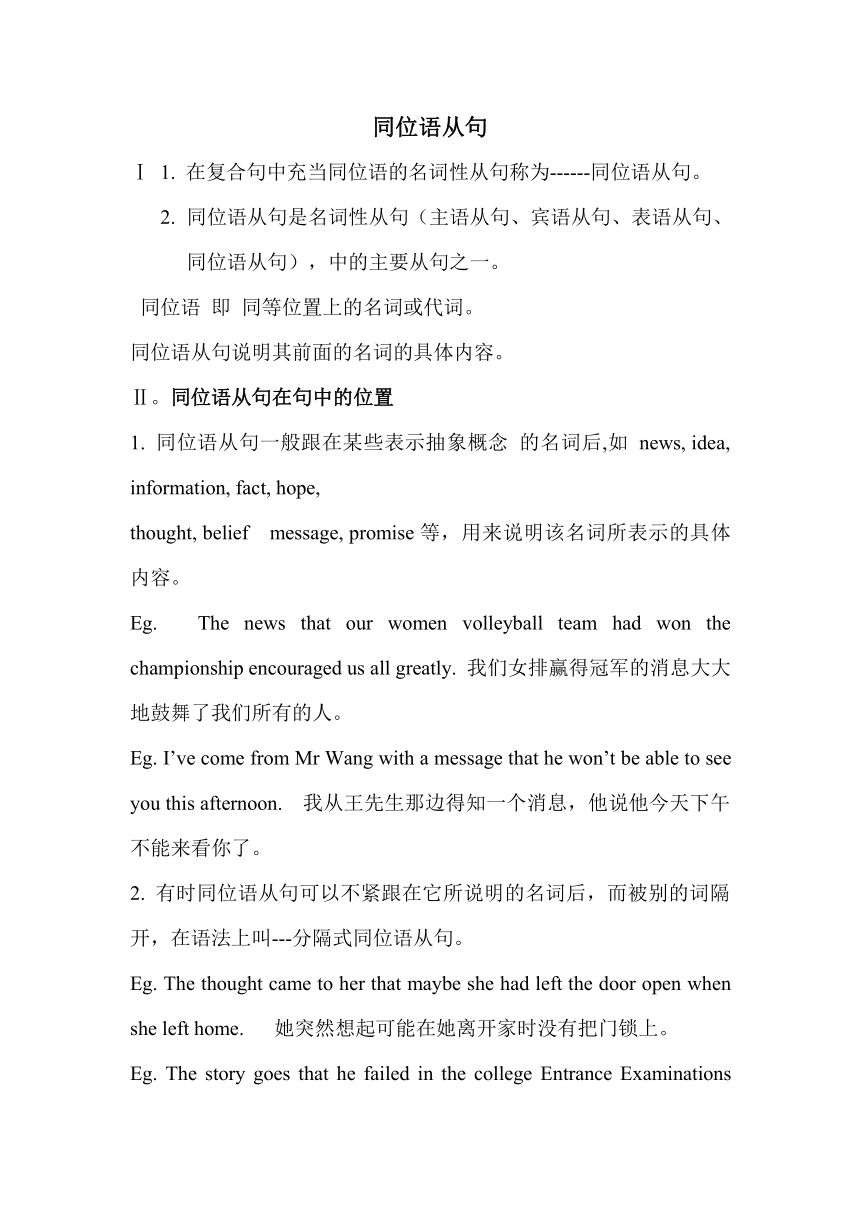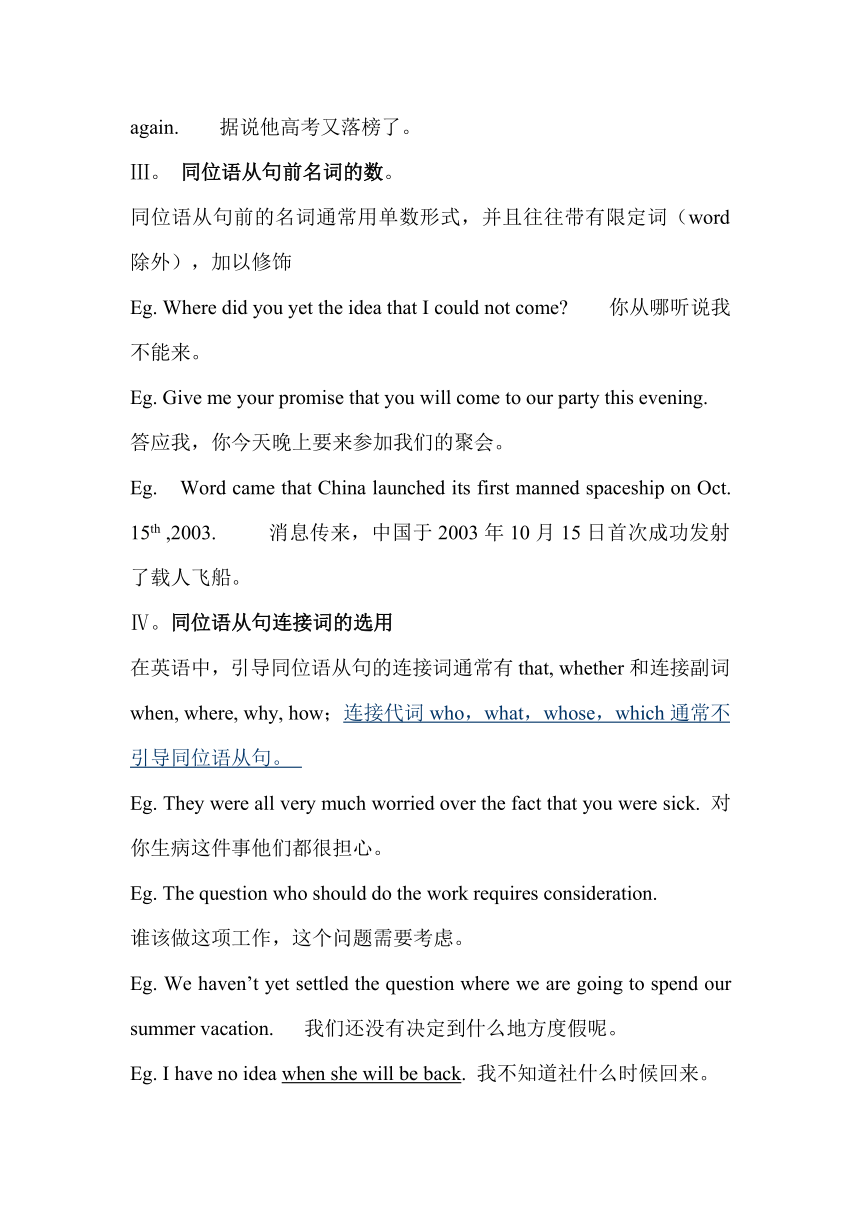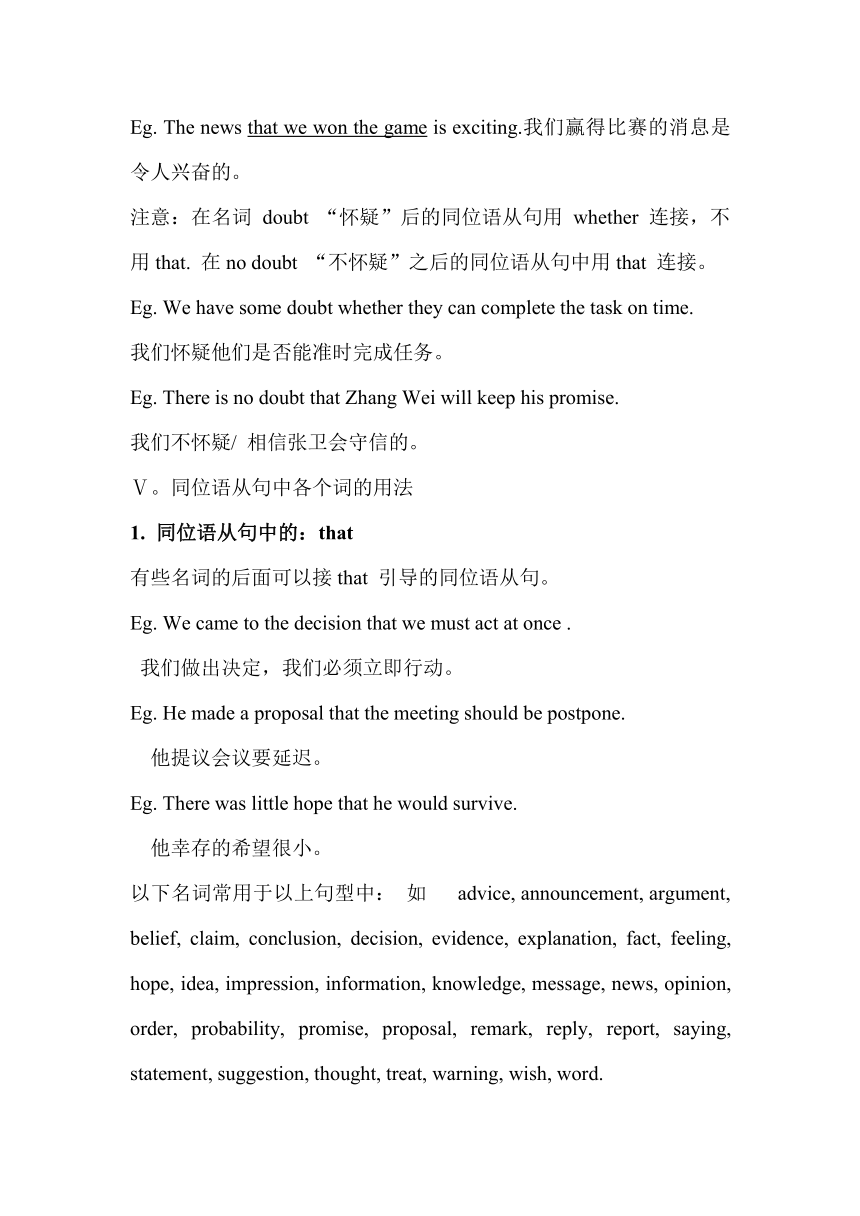同位语从句
图片预览



文档简介
同位语从句
Ⅰ 1. 在复合句中充当同位语的名词性从句称为------同位语从句。
同位语从句是名词性从句(主语从句、宾语从句、表语从句、同位语从句),中的主要从句之一。
同位语 即 同等位置上的名词或代词。
同位语从句说明其前面的名词的具体内容。
Ⅱ。同位语从句在句中的位置
1. 同位语从句一般跟在某些表示抽象概念 的名词后,如 news, idea, information, fact, hope,
thought, belief message, promise等,用来说明该名词所表示的具体内容。
Eg. The news that our women volleyball team had won the championship encouraged us all greatly. 我们女排赢得冠军的消息大大地鼓舞了我们所有的人。
Eg. I’ve come from Mr Wang with a message that he won’t be able to see you this afternoon. 我从王先生那边得知一个消息,他说他今天下午不能来看你了。
2. 有时同位语从句可以不紧跟在它所说明的名词后,而被别的词隔开,在语法上叫---分隔式同位语从句。
Eg. The thought came to her that maybe she had left the door open when she left home. 她突然想起可能在她离开家时没有把门锁上。
Eg. The story goes that he failed in the college Entrance Examinations again. 据说他高考又落榜了。
Ⅲ。 同位语从句前名词的数。
同位语从句前的名词通常用单数形式,并且往往带有限定词(word除外),加以修饰
Eg. Where did you yet the idea that I could not come 你从哪听说我不能来。
Eg. Give me your promise that you will come to our party this evening.
答应我,你今天晚上要来参加我们的聚会。
Eg. Word came that China launched its first manned spaceship on Oct. 15th ,2003. 消息传来,中国于2003年10月15日首次成功发射了载人飞船。
Ⅳ。同位语从句连接词的选用
在英语中,引导同位语从句的连接词通常有that, whether和连接副词when, where, why, how;连接代词who,what,whose,which通常不引导同位语从句。
Eg. They were all very much worried over the fact that you were sick. 对你生病这件事他们都很担心。
Eg. The question who should do the work requires consideration.
谁该做这项工作,这个问题需要考虑。
Eg. We haven’t yet settled the question where we are going to spend our summer vacation. 我们还没有决定到什么地方度假呢。
Eg. I have no idea when she will be back. 我不知道社什么时候回来。
Eg. The news that we won the game is exciting.我们赢得比赛的消息是令人兴奋的。
注意:在名词 doubt “怀疑”后的同位语从句用 whether 连接,不用that. 在no doubt “不怀疑”之后的同位语从句中用that 连接。
Eg. We have some doubt whether they can complete the task on time.
我们怀疑他们是否能准时完成任务。
Eg. There is no doubt that Zhang Wei will keep his promise.
我们不怀疑/ 相信张卫会守信的。
Ⅴ。同位语从句中各个词的用法
同位语从句中的:that
有些名词的后面可以接that 引导的同位语从句。
Eg. We came to the decision that we must act at once .
我们做出决定,我们必须立即行动。
Eg. He made a proposal that the meeting should be postpone.
他提议会议要延迟。
Eg. There was little hope that he would survive.
他幸存的希望很小。
以下名词常用于以上句型中: 如 advice, announcement, argument, belief, claim, conclusion, decision, evidence, explanation, fact, feeling, hope, idea, impression, information, knowledge, message, news, opinion, order, probability, promise, proposal, remark, reply, report, saying, statement, suggestion, thought, treat, warning, wish, word.
同位语从句中的: whether
whether 可以引导同位语从句,而定语从句不能用whether 作引导词。
eg. He hasn’t made the decision whether he will go there.
他还没有做出决定是否去那里。
eg. I have small doubt whether he is suitable for the job.
他是否适合这件工作我有点怀疑。
同位语从句: what
what 可以引导同位语从句,而定语从句不能用what 作为引导词。
eg. I have no idea what he is doing now.
我不知道他现在在干什么。
同位语从句: how
how 可以引导同位语从句而定语从句不能用how 作为引导词。
eg. It’s a question how he did it.
那是一个他如何做了此事的问题。
同位语从句: who
who, whom, which , when, where, why 用了引导同位语从句。
eg. The question who should do the work requires consideration.
谁该干这项工作,这个问题需要考虑。
eg. She raised the question where we could get the fund.
她提出这个问题,我们到哪儿去搞这笔资金。
Ⅵ。 同位语从句的语气
在 suggestion , advice, request, order 等意为“建议, 命令,要求”的名词后,同位语从句中的谓语动词通常用“should+v ” 的虚拟语气结构,句中的should 可以省略。
eg. Our teacher gave us some advice how we ( should) use the computer.
老师给我们提出了一些如何使用电脑的建议 。
eg. The suggestion came fro the chairman that the new rule (should) be adopted.
采纳新规则的建议是主席提出来的
eg. The government gave the order that all these houses ( should) be pulled down in three weeks.
政府下令在三个星期内所有的这些房子都要拆掉。
Ⅶ。 同位语从句与定语从句的用法和区别
区别(1)
同位语从句和先行词是同等的关系,而定语从句是用来修饰先行词,是从属关系。
区别(2)
that 在同位语从句中没有词义, 不从当句子成分;而定语从句中充当主语、宾语、表语、等句子成分。
区别(3)
whether, what, how 可以用来引导同位语从句;而它们不能用来引导定语从句。
区别(4)
从词义角度看问题
who, whom, which , when, where, why 用来引导同位语从句是保持原来疑问词的意义;它们用来引导定语从句时, 不具有疑问词的含义。
从搭配角度看问题
who, whom, which, when, where, why 用来引导定语从句时对立性很强,如,先行词是 “人” 引导词用 “who” 等, 而它们引导同位语从句时,先行词通常是 “question , idea, doubt 等”
Ⅷ 典型例题
eg1. I have no idea when he will be back.
解析:he will be back 意义不完整,应加“什么时候”的含义才能表达idea 的全部内容,因此用when 引导同位语从句。
eg2. I have no impression how he went home, perhaps by bike.
解析: he went home, 意义不完整,应加上“如何”的含义才能表达impression 的全部内容,因此用how引导同位语从句。
eg3. Information has been put forward __B__ more middle school graduates will be admitted into universities. ( NMET 2001 上海)
A. while B. what C. when D. as
解析:“ more…….universities ” 是information 的内容,而且 information 不在从句中作成分,所以该句为同位语从句。
eg4. It is said that more middle school graduates will be admitted into universities, this is the information __B__ has been put forward.
A. what B. that C. when D. as
解析: 此句中定语从句, “information 在后边的定语从句中作主语。
eg5. She heard a terrible noise, __B__ brought her heart into her mouth.
A. it B. which C. this D. that
解析: 此句为非限制性定语从句,先行词为 “ a terrible noise ” 并且它在从句中作主语。
eg6. I can’t stand the terrible noise __D___ she is crying loudly.
A. it B. which C. this D. that
解析:She is crying loudly 是 the terrible noise 的内容。并且 the terrible noise 不在从句中作成分,所以该句为同位语从句。
例句:
The news that I have passed the exam is true. ( 同位语从句)
The news that he told me just now is true. (定语从句)
The idea that computers can recognize human voices surprises many people. (同位语从句)
The idea that he gave surprises many people. ( 宾语从句)
Do you remember the day when I told you that I loved you (定语从句)
I have asked the question why it was true just now . ( 同位语从句)
Ⅰ 1. 在复合句中充当同位语的名词性从句称为------同位语从句。
同位语从句是名词性从句(主语从句、宾语从句、表语从句、同位语从句),中的主要从句之一。
同位语 即 同等位置上的名词或代词。
同位语从句说明其前面的名词的具体内容。
Ⅱ。同位语从句在句中的位置
1. 同位语从句一般跟在某些表示抽象概念 的名词后,如 news, idea, information, fact, hope,
thought, belief message, promise等,用来说明该名词所表示的具体内容。
Eg. The news that our women volleyball team had won the championship encouraged us all greatly. 我们女排赢得冠军的消息大大地鼓舞了我们所有的人。
Eg. I’ve come from Mr Wang with a message that he won’t be able to see you this afternoon. 我从王先生那边得知一个消息,他说他今天下午不能来看你了。
2. 有时同位语从句可以不紧跟在它所说明的名词后,而被别的词隔开,在语法上叫---分隔式同位语从句。
Eg. The thought came to her that maybe she had left the door open when she left home. 她突然想起可能在她离开家时没有把门锁上。
Eg. The story goes that he failed in the college Entrance Examinations again. 据说他高考又落榜了。
Ⅲ。 同位语从句前名词的数。
同位语从句前的名词通常用单数形式,并且往往带有限定词(word除外),加以修饰
Eg. Where did you yet the idea that I could not come 你从哪听说我不能来。
Eg. Give me your promise that you will come to our party this evening.
答应我,你今天晚上要来参加我们的聚会。
Eg. Word came that China launched its first manned spaceship on Oct. 15th ,2003. 消息传来,中国于2003年10月15日首次成功发射了载人飞船。
Ⅳ。同位语从句连接词的选用
在英语中,引导同位语从句的连接词通常有that, whether和连接副词when, where, why, how;连接代词who,what,whose,which通常不引导同位语从句。
Eg. They were all very much worried over the fact that you were sick. 对你生病这件事他们都很担心。
Eg. The question who should do the work requires consideration.
谁该做这项工作,这个问题需要考虑。
Eg. We haven’t yet settled the question where we are going to spend our summer vacation. 我们还没有决定到什么地方度假呢。
Eg. I have no idea when she will be back. 我不知道社什么时候回来。
Eg. The news that we won the game is exciting.我们赢得比赛的消息是令人兴奋的。
注意:在名词 doubt “怀疑”后的同位语从句用 whether 连接,不用that. 在no doubt “不怀疑”之后的同位语从句中用that 连接。
Eg. We have some doubt whether they can complete the task on time.
我们怀疑他们是否能准时完成任务。
Eg. There is no doubt that Zhang Wei will keep his promise.
我们不怀疑/ 相信张卫会守信的。
Ⅴ。同位语从句中各个词的用法
同位语从句中的:that
有些名词的后面可以接that 引导的同位语从句。
Eg. We came to the decision that we must act at once .
我们做出决定,我们必须立即行动。
Eg. He made a proposal that the meeting should be postpone.
他提议会议要延迟。
Eg. There was little hope that he would survive.
他幸存的希望很小。
以下名词常用于以上句型中: 如 advice, announcement, argument, belief, claim, conclusion, decision, evidence, explanation, fact, feeling, hope, idea, impression, information, knowledge, message, news, opinion, order, probability, promise, proposal, remark, reply, report, saying, statement, suggestion, thought, treat, warning, wish, word.
同位语从句中的: whether
whether 可以引导同位语从句,而定语从句不能用whether 作引导词。
eg. He hasn’t made the decision whether he will go there.
他还没有做出决定是否去那里。
eg. I have small doubt whether he is suitable for the job.
他是否适合这件工作我有点怀疑。
同位语从句: what
what 可以引导同位语从句,而定语从句不能用what 作为引导词。
eg. I have no idea what he is doing now.
我不知道他现在在干什么。
同位语从句: how
how 可以引导同位语从句而定语从句不能用how 作为引导词。
eg. It’s a question how he did it.
那是一个他如何做了此事的问题。
同位语从句: who
who, whom, which , when, where, why 用了引导同位语从句。
eg. The question who should do the work requires consideration.
谁该干这项工作,这个问题需要考虑。
eg. She raised the question where we could get the fund.
她提出这个问题,我们到哪儿去搞这笔资金。
Ⅵ。 同位语从句的语气
在 suggestion , advice, request, order 等意为“建议, 命令,要求”的名词后,同位语从句中的谓语动词通常用“should+v ” 的虚拟语气结构,句中的should 可以省略。
eg. Our teacher gave us some advice how we ( should) use the computer.
老师给我们提出了一些如何使用电脑的建议 。
eg. The suggestion came fro the chairman that the new rule (should) be adopted.
采纳新规则的建议是主席提出来的
eg. The government gave the order that all these houses ( should) be pulled down in three weeks.
政府下令在三个星期内所有的这些房子都要拆掉。
Ⅶ。 同位语从句与定语从句的用法和区别
区别(1)
同位语从句和先行词是同等的关系,而定语从句是用来修饰先行词,是从属关系。
区别(2)
that 在同位语从句中没有词义, 不从当句子成分;而定语从句中充当主语、宾语、表语、等句子成分。
区别(3)
whether, what, how 可以用来引导同位语从句;而它们不能用来引导定语从句。
区别(4)
从词义角度看问题
who, whom, which , when, where, why 用来引导同位语从句是保持原来疑问词的意义;它们用来引导定语从句时, 不具有疑问词的含义。
从搭配角度看问题
who, whom, which, when, where, why 用来引导定语从句时对立性很强,如,先行词是 “人” 引导词用 “who” 等, 而它们引导同位语从句时,先行词通常是 “question , idea, doubt 等”
Ⅷ 典型例题
eg1. I have no idea when he will be back.
解析:he will be back 意义不完整,应加“什么时候”的含义才能表达idea 的全部内容,因此用when 引导同位语从句。
eg2. I have no impression how he went home, perhaps by bike.
解析: he went home, 意义不完整,应加上“如何”的含义才能表达impression 的全部内容,因此用how引导同位语从句。
eg3. Information has been put forward __B__ more middle school graduates will be admitted into universities. ( NMET 2001 上海)
A. while B. what C. when D. as
解析:“ more…….universities ” 是information 的内容,而且 information 不在从句中作成分,所以该句为同位语从句。
eg4. It is said that more middle school graduates will be admitted into universities, this is the information __B__ has been put forward.
A. what B. that C. when D. as
解析: 此句中定语从句, “information 在后边的定语从句中作主语。
eg5. She heard a terrible noise, __B__ brought her heart into her mouth.
A. it B. which C. this D. that
解析: 此句为非限制性定语从句,先行词为 “ a terrible noise ” 并且它在从句中作主语。
eg6. I can’t stand the terrible noise __D___ she is crying loudly.
A. it B. which C. this D. that
解析:She is crying loudly 是 the terrible noise 的内容。并且 the terrible noise 不在从句中作成分,所以该句为同位语从句。
例句:
The news that I have passed the exam is true. ( 同位语从句)
The news that he told me just now is true. (定语从句)
The idea that computers can recognize human voices surprises many people. (同位语从句)
The idea that he gave surprises many people. ( 宾语从句)
Do you remember the day when I told you that I loved you (定语从句)
I have asked the question why it was true just now . ( 同位语从句)
